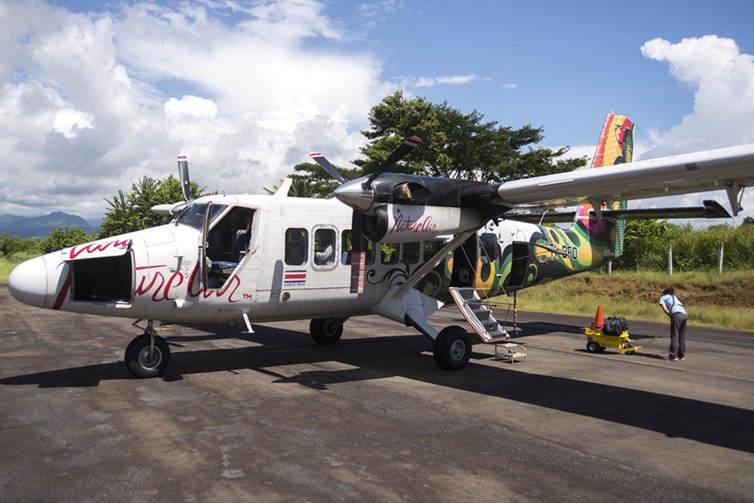
A Nature Air De Havilland Canada DHC-6-300 Twin Otter/VistaLiner at La Managua Airport, Quepos, Costa Rica – Photo: Daniel T Jones
It is easy to find travel sites touting Costa Rica as the new Hawaii for tropical vacation destinations. I had intended to test this theory for some time, and see some sloths and monkeys in the process. Having found a discount fare for my girlfriend and me from Tijuana to San Jos via Guadalajara, my AvGeek/travel skills were put to use to figure out how to get from the Costa Rican capital of San Jos to our intended destination, the Pacific coast town of Quepos.
NATURE AIR: Background & Aircraft
Ten seconds of Googling later, it was readily apparent that roads, road travel, car rentals, and long distance bus service in the country were less than ideal. Not expecting to find many other options, as Costa Rica is a very small country (roughly 80% the size of West Virginia), I was pleasantly surprised to find not one, but two, choices for domestic air travel in the region. SANSA Airlines (Servicios Areos Nacionales S.A.) operates a fleet of eight Cessna 208B Grand Caravans from its hub at Juan Santamaràa International Airport (SJO/MROC). As nice as a ride in a C208 sounds, I decided to go with SANSA’s main competitor, Nature Air.
I chose Nature Air for a few reasons, the most important being that they fly the De Havilland Canada DHC-6 Twin Otter 300, as well as a few Cessna 208Bs – but more on their fleet later. Specifically, they operate the ’œVistaLiner’ model, with oversized windows. As if that weren’t enough to choose them, they have some of the most amazing aircraft liveries you’ll ever see!
Nature Air was founded in 1990 as Travel Air, but was renamed in 2000 after partnering with a tourism consulting company. In 2004, they became the world’s first carbon-neutral airline by offsetting carbon releases through donating funds to FONAFIFO (Fondo Nacional De Financiamiento Forestal), a public entity in charge of ’œfinancing small-sized and medium producers of forest goods and services, by procuring and managing national and international financial resources to support development of the forestry sector.’ Essentially, this division of the Environmental Ministry finances preservation and reforestation efforts for important tracts of rain forest in Costa Rica.
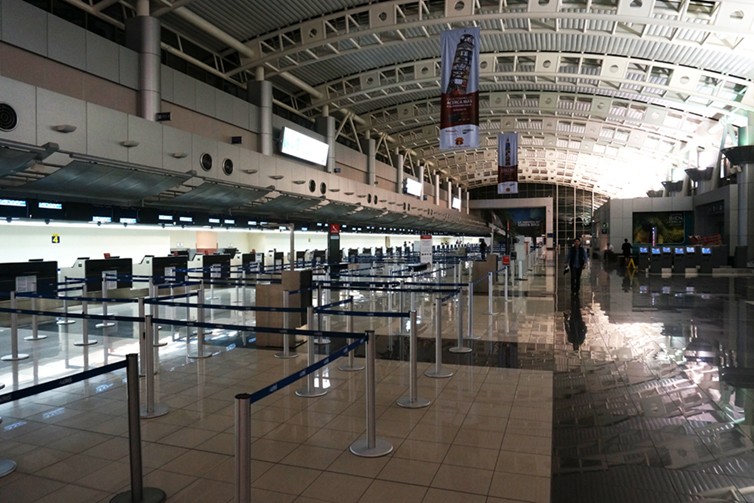
Check-in hall at Juan Santamaràa International Airport, San Jos, Costa Rica – Photo: Daniel T Jones
The morning of our travel from San Jos Juan Santamaràa International Airport (SJO) to Quepos La Managua Airport (XQP), we arrived at the San Jos airport a few hours earlier than would be required, as I was given the opportunity on behalf of AirlineReporter to speak with Nature Air’s Customer Service and Airports Manager, Gabriela Mejia. We sat down for a chat over breakfast in a restaurant overlooking the five-year-old, very modern and stylish ticketing hall in San Jos. We had a pleasant meeting discussing Nature Air’s plans for the future, as well as their community engagement.
- Nature Air Let L-410 Turbolet – Image: Nature Air
- Nature Air Let L-410 Turbolet – Image: Nature Air
- Nature Air Let L-410 Turbolet – Image: Nature Air
- Interior of a Nature Air Let L-410 Turbolet – Image: Nature Air
The airline is currently undergoing a fleet renewal, transitioning from the older Twin Otters to newly leased Let L-410 Turbolets. The Czech aircraft have recently arrived from the previous operator in South Africa, where they were operated on behalf of the United Nations. Three of the 410s are currently in Costa Rica undergoing preparations for service with Nature, with a fourth on the way. By the end of the year, the Cessna 208Bs and all but one Twin Otter will be removed from service and the fleet will consist of one Twin Otter and four Let L-410s. The new aircraft will have a capacity of 19 (on new leather seats) and can travel faster than their current fleet to cut flying time by as much as 15%, which will allow more flights per day.
The airline held a contest open to citizens of Costa Rica and Nicaragua to design the tail art for the new planes. The L-410s will likely have different liveries on each side of the plane.
Currently, Nature Air flies to 15 cities (some seasonal) in Costa Rica, Nicaragua, and Panama; mainly from their hub in San Jos. According to Ms. Mejia, the likely next destination for expansion is David, Panama. Long-term, the airline is potentially considering acquiring even larger aircraft such as the Saab 340 or Embraer E120 for further expansion in the region.
Gabriela was also happy to tell us about the airline’s efforts to give back to the Central American region and Costa Rica. They currently fund an English language school in Drake Bay for boat operators and hotel staff to boost tourism in the area. The plan is to potentially open more of these facilities around the region.
The facet of Nature Air that excites them the most is the flying experience itself. The company brands itself as not just an airline, but a travel company with wings. Gabriela further emphasized this by saying ’œWe are not just an airline; we want to be another part of your experience on your vacation.’ I decided that it was my AvGeek duty to test this idea. Being a lifelong AvGeek, I was pretty certain that I was going to enjoy the flight, but wasn’t sure if my ’œAvGeek-tolerating’ girlfriend would feel the same way.
- Nature Air departure gate, Juan Santamaràa International Airport, San Jos, Costa Rica – Photo: Daniel T Jones
- Nature Air boarding passes – Photo: Daniel T Jones
NATURE AIR: The flight experience
We parted ways with Gabriela and checked in for the flight. Being a small airline, there was zero line for check-in, and the friendly counter staff quickly had us and our bags weighed for weight and balance, checked in, and on our way to security. For domestic flights, passengers use a separate security line which would theoretically be a quicker way through security; however, the security lines were all empty anyway.
Somewhere around four minutes after leaving the check-in counter, we settled in for the short wait for boarding at our assigned gate. Nature Air uses a remote gate with busing from the terminal to the aircraft, which is boarded from the general aviation ramp at the west end of the airport. All eight passengers boarded the bus from the lower level of the terminal for the five-minute ride to the aircraft. While some might feel inconvenienced by the remote boarding, I was excited to be getting what was essentially a ramp tour in a bus with open windows.
- An unmarked Embraer 190AR, possibly belonging to Copa Airlines Colombia (Aero Republica) – Photo: Daniel T Jones
- A UM Air McDonnell Douglas MD-82 (DC-9-82) is hiding in there, I promise – Photo: Daniel T Jones
- A Cayman Airways Boeing 737-36E undergoing maintenance – Photo: Daniel T Jones
It was a thrill to pass within feet of aircraft sitting around various parts of the airport, including some unusual/interesting aircraft at the COOPESA maintenance hangar. These included a Cayman Airways 737-300, a Surinam Airways 737-300, a UM Airlines MD-82, and an AtlasGlobal A320 cargo conversion, among others.
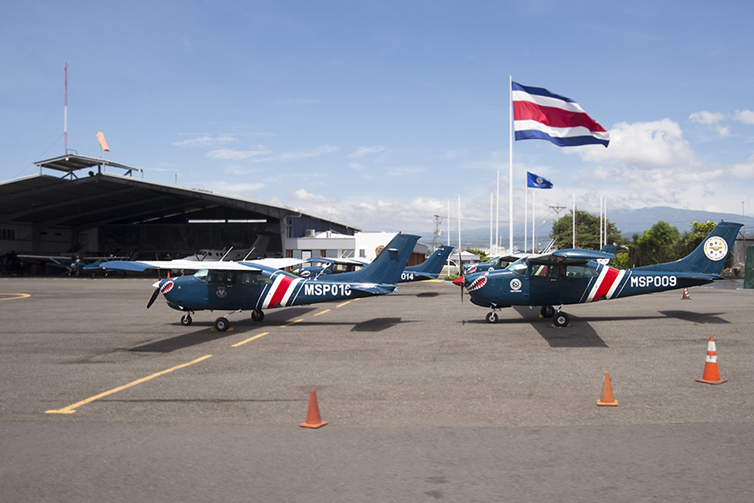
Several Cessna T210N Turbo Centurions belonging to Ministerio de Seguridad Pública (Costa Rican Ministry of Public Security) – Photo: Daniel T Jones
Our aircraft shared a ramp with general aviation aircraft and the those of the Costa Rican Ministry of Public Security (Ministerio de Seguridad Pública), which is a police force that acts as the country’s military, ground security, law enforcement, counter-narcotics, border patrol, and tourism security.
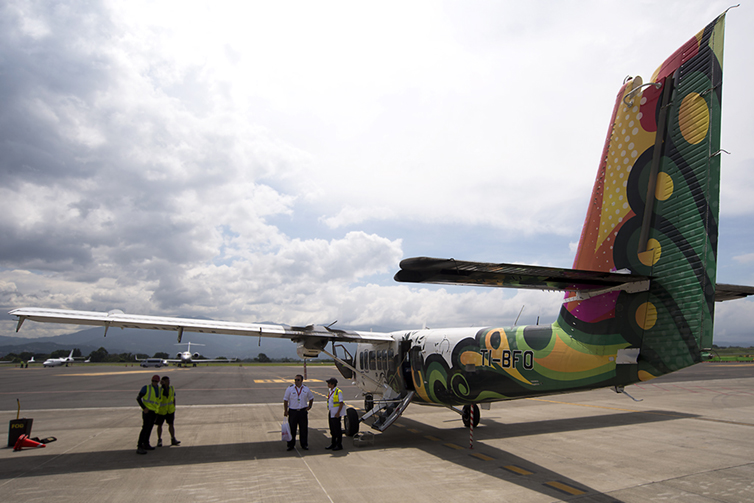
Flight and ground crews of a Nature Air De Havilland Canada DHC-6-300 Twin Otter/VistaLiner – Photo: Daniel T Jones
The bus from the terminal stopped at the tail of the aircraft and we gathered our bags to board. Waiting for us under the shade of the wing was our pilot, co-pilot, and the ground crew. We were all personally greeted by the pilot, who offered to take photos with phones or cameras in front of the aircraft.

Ready to board a Nature Air De Havilland Canada DHC-6-300 Twin Otter/VistaLiner – Photo: Daniel T Jones
Our beautifully painted aircraft, registered TI-BFO, basking in the Costa Rican sun, was quite hot inside until the engines were started and air flow through the cabin became available. Not five minutes after arriving at the aircraft and crawling aboard (not an easy task in a small plane when you’re 6’5’), the engines were running and we were ready to taxi. It’s somewhat of an unusual feeling to be sitting in a commercial aircraft and be watching the pilot’s every move.
For a small plane, there is ample room in the cabin. The seating is three-abreast and, due to the shape of the cabin, it feels roomier than it looks. I really doubt anyone cared about the interior anyway, as the huge windows direct your attention outside.
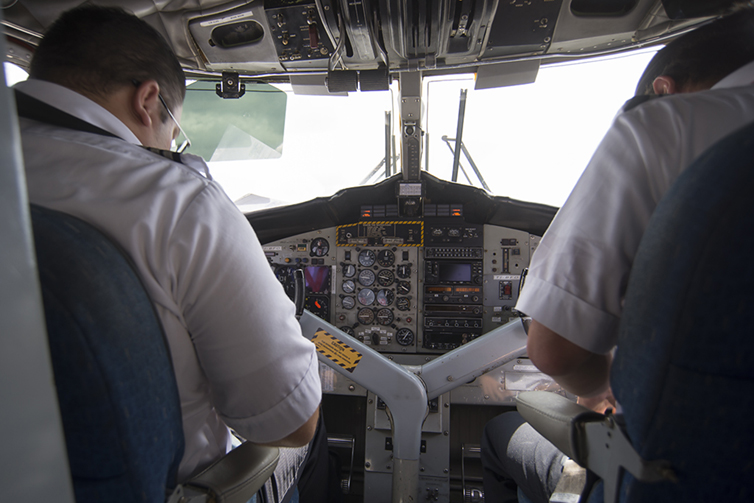
No flight attendant nor cockpit door on a Nature Air De Havilland Canada DHC-6-300 Twin Otter/VistaLiner – Photo: Daniel T Jones
Takeoff was smooth and quick, although somewhat noisy (but honestly I could listen to the drone of those engines all day long). Shortly we were skimming amongst the clouds at 5000-6000’ (I could read the altimeter from my seat) getting a bird’s-eye view of a beautiful country for the 20-minute flight.
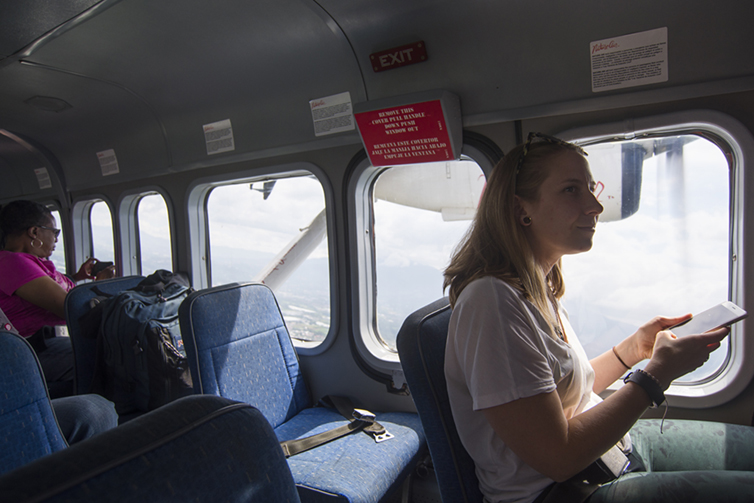
Fantastic view out all sides of a Nature Air De Havilland Canada DHC-6-300 Twin Otter/VistaLiner – Photo: Daniel T Jones
Although Nature Air offers direct flights from SJO to XQP, any self-respecting AvGeek would choose to do what I did, which is to fly to Quepos via La Fortuna. Not only does this offer more time in an amazing aircraft, it also allowed us to see Volcán Arenal, just a few miles west of La Fortuna, and from the air no less.
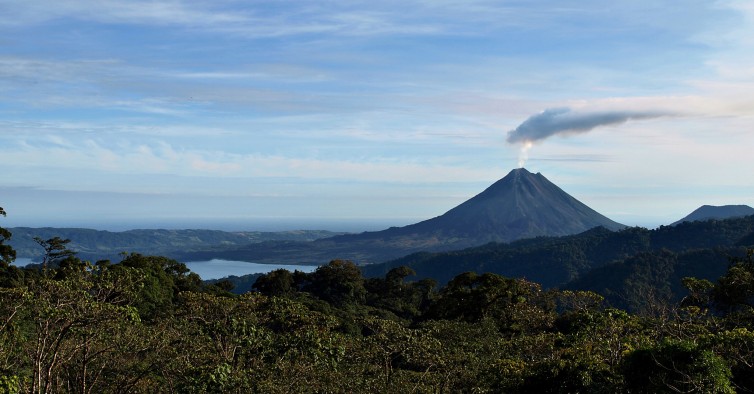
Volcán Arenal – Photo: Timothy Reber | FlickrCC
Arenal Airport (FON/MRAN) is actually a private airstrip located in La Fortuna/San Carlos, Costa Rica. The terminal is nothing more than a small glassed-in building that is mostly a restaurant, and the runway is a narrow, marginally paved strip in the middle of agricultural fields.
After less than 10 minutes in La Fortuna, dropping off some passengers and picking up a few others, we were taxiing out for departure to Quepos. The captain explained that after we took off he would make a short detour turn to the northwest so passengers on each side could get an unobstructed look at the volcano. Even though the very top was obscured by clouds, it was still a wonderful treat to see the volcano up close through the huge windows of the Twin Otter. Turning south, we soared amongst the clouds near the coast for the next 30 minutes before beginning our descent into Quepos.
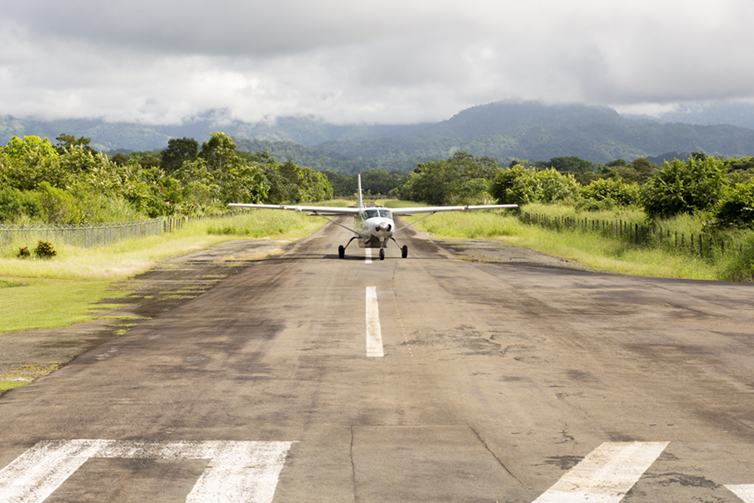
A Sansa Regional Cessna 208B Grand Caravan arriving at La Managua Airport, Quepos, Costa Rica – Photo: Daniel T Jones
Quepos La Managua Airport is a tiny airstrip nestled in between palm oil plantations, less than one mile east of the coastal town of Quepos. On approach and after landing it seemed as though our wingtips were skimming the palm fronds just beyond the edge of the runway. It really felt like we had landed in the jungle.
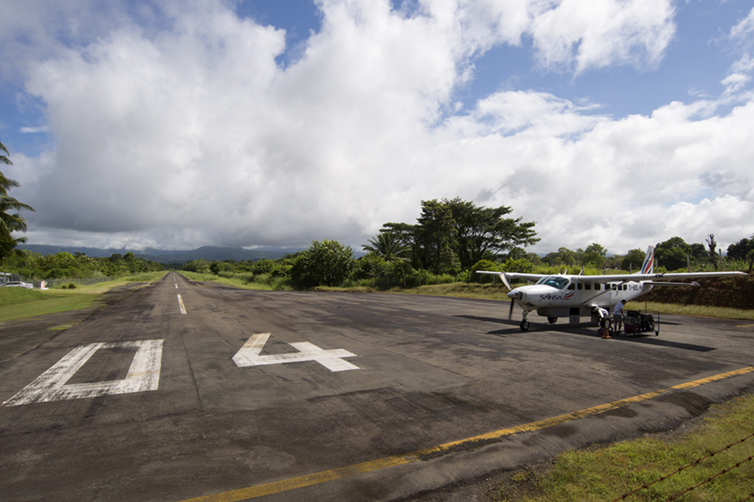
A Sansa Regional Cessna 208B Grand Caravan on the “ramp” at La Managua Airport, Quepos, Costa Rica – Photo: Daniel T Jones
The ’œramp’ at Quepos is basically a small apron at the western end of the runway. We exited the aircraft directly onto the ramp/runway and walked the 50 feet to the ’œterminal’. I use that term loosely, as it is basically an open-air tin shed. In fact, you can exit the airport through a chain link gate, after paying the airport use fee of $3 (US dollars are used widely in Costa Rica), without even going through the terminal.
NATURE AIR: Final thoughts
In truth, this was a fitting ending to a really wonderful flight experience. The laid back attitude was a perfect complement to the Nature Air service. I realized that Gabriela from Nature Air was exactly right; flying this fun little airline was more than travel, it was an experience. For the record, my non-AvGeek girlfriend loved it as much as, if not more than, me.
I left the airport wishing I had somewhere else to travel so that I could spend more time with Nature Air. Instead, we got to spend the next six days enjoying the paradise that is Costa Rica.
Some more #AVGeek photos from San Jos Juan Santamaràa International Airport for your enjoyment’¦
- Cubana Antonov An-158 – Photo: Daniel T Jones
- Avianca Airbus A321-231 – Photo: Daniel T Jones
- Star Alliance (Avianca) Airbus A319-132 – Photo: Daniel T Jones
- Copa Airlines Boeing 737-8V3 with MLB special logos – Photo: Daniel T Jones
- Air Panama Fokker 100 (F-28-0100) – Photo: Daniel T Jones
- Oneworld (American Airlines) Boeing 737-823 – Photo: Daniel T Jones
- Interjet Sukhoi SSJ-100-95B Superjet 100 – Photo: Daniel T Jones
- Iberia Airbus A340-642, the largest aircraft operating scheduled passenger service to Costa Rica – Photo: Daniel T Jones
- AeroMexico Boeing 737-752 – Photo: Daniel T Jones
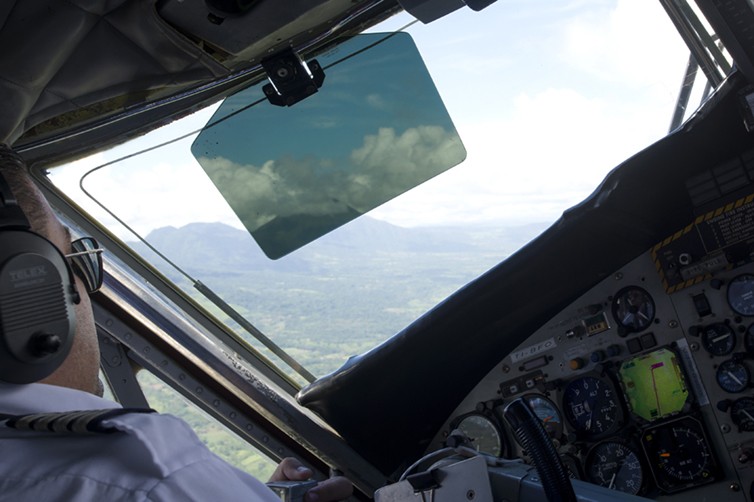
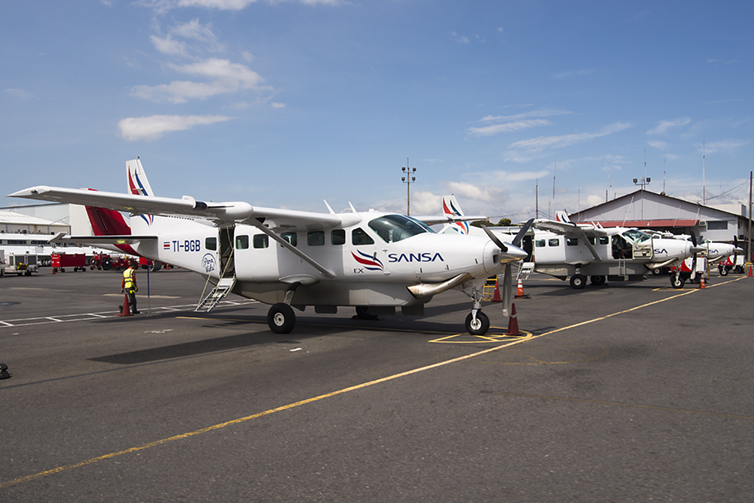
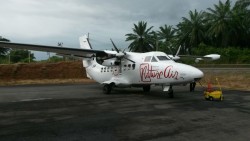
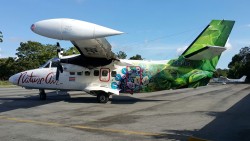
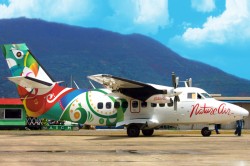
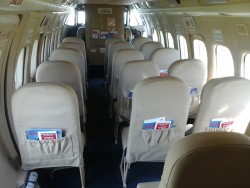
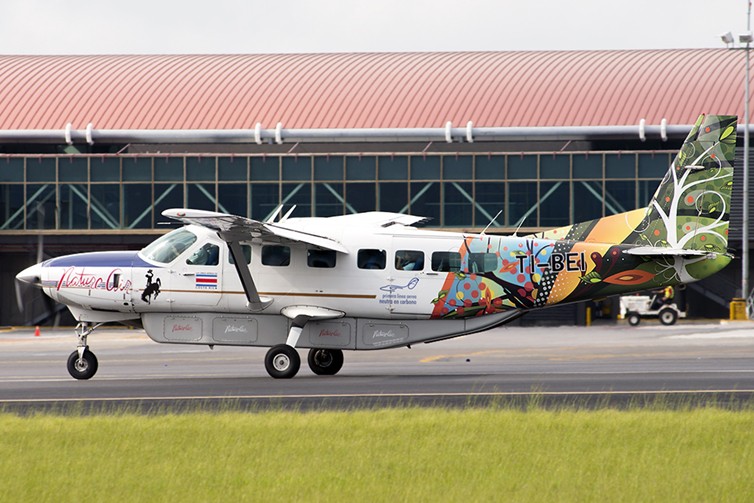
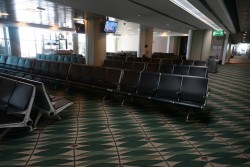
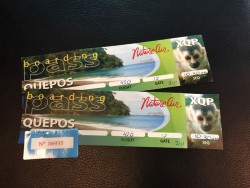
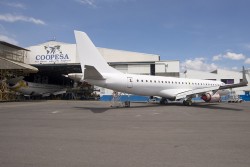
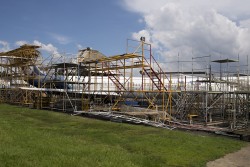
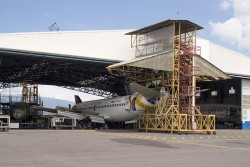
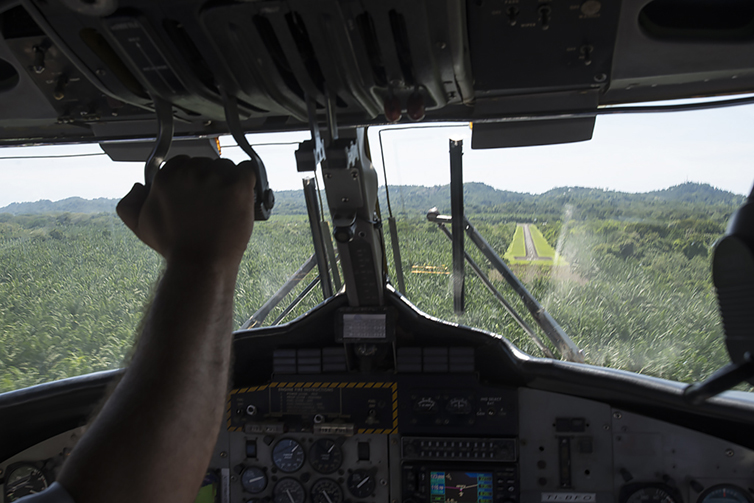
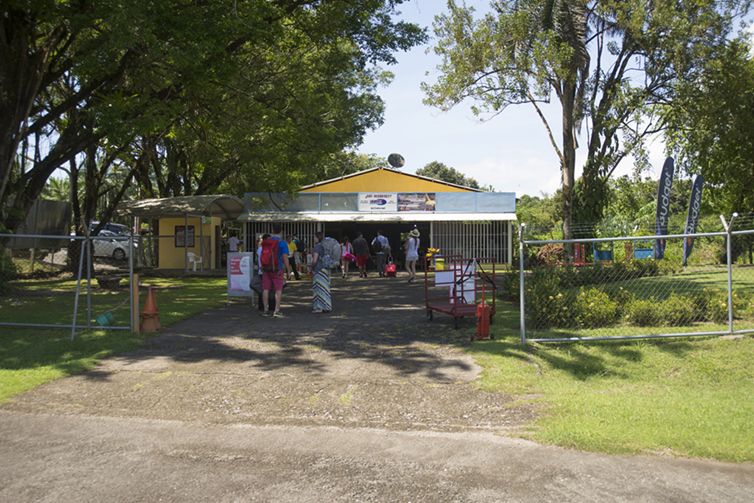
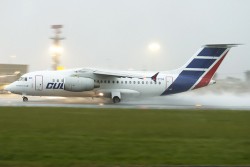
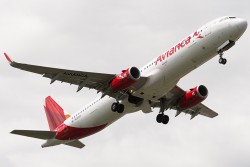
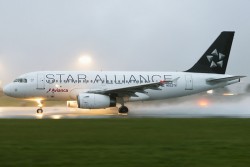
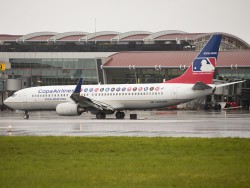
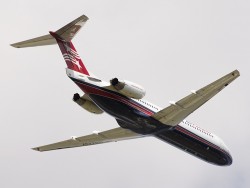
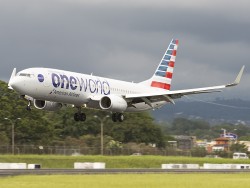
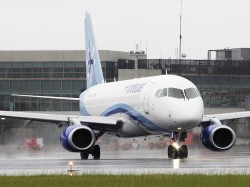
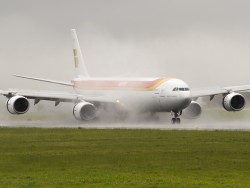
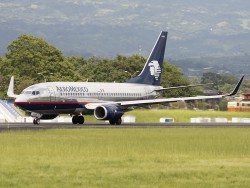
I have similar warm fuzzies for Nature Air. My flight with them was my wife’s first experience in a smaller aircraft, and it was really fun to watch her go from apprehensive to thrilled in the span of about three minutes. That, and Nature Air turned what would be a 4-hour drive into a 15-minute flight.
I hope you saw your monkeys (plenty of them in Manuel Antonio) and that you made time to visit El Avion, which is still my favorite airplane-turned-into-a-restaurant.
Justin, I could have written 5000 more words about Manuel Antonio/Quepos alone. We saw howler/squirrel/capuchin monkeys every day and sloths most days. We visited El Avion for a drink and jumped up into the cockpit of course, and there was a sloth eating in a tree 10 feet off the back deck of the restaurant. The owner of El Avion has two other restaurants down the street that have basically the same food for lower prices.
I wish we had flown back from Quepos to SJO, but we drove back and it was a moderately pleasant 3 hour drive although driving rules are basically non-existent. I don’t regret having done that but also wish I had flown Nature more.
Although not my girlfriend’s fist experience in a small aircraft, she’s flown in Cessnas with me, but she was immediately thrilled, same as your wife.
Very cool – glad you had so much fun!
Thanks for the excellent post, including wonderful pix. Having flown on countless Twin Otters in a variety of environments, I cannot recall encountering anyone who did not love the airplane within minutes. It will do almost anything, including making new friends quickly. -C.
Thanks! 100% agree (obviously)
Great story and pictures from your experience! It has been many years since I have flown on a Twin Otter (Winair from SXM/SBH a few different times) but I remember vividly the sounds of those engines revving up for take-off and it gets the adrenaline going (so I thought until I saw the landing we were making at SBH!). While I have no doubt the L-410’s will be a fine bird, I am a bit nostalgic to see the Twin Otters replaced (minus one).
great story. I am Costa Rican and travelling in one of these is always a fun experience.
A shame that you say out ministry stands for the military. Locals would never say that. We are proud to be a country with no military for ~60 years.
Thank you for some other excellent post. The place else could anybody get that kind of information in such a perfect method of
writing? I’ve a presentation next week, and I’m
on the look for such info.